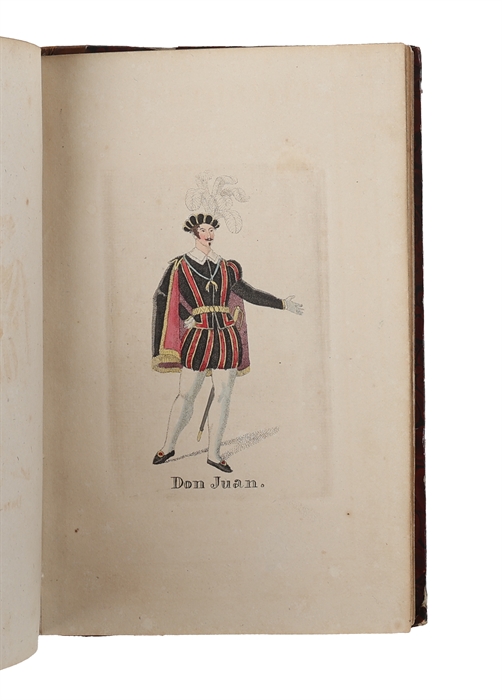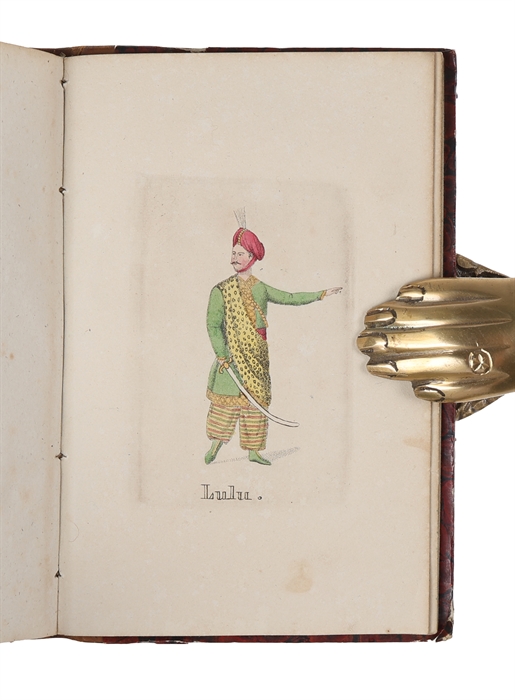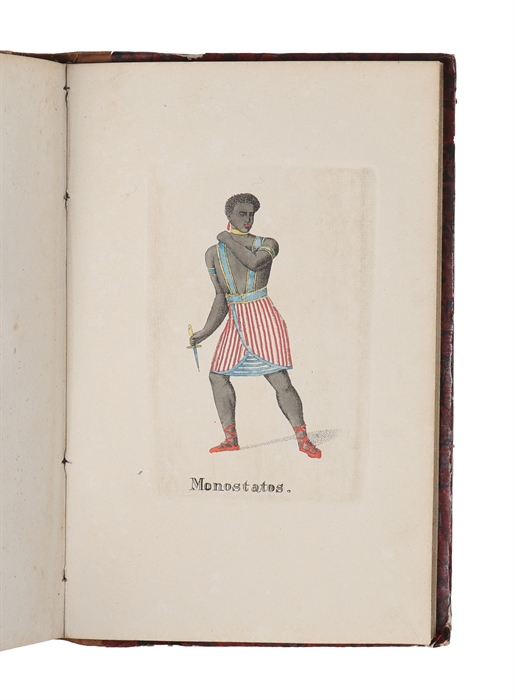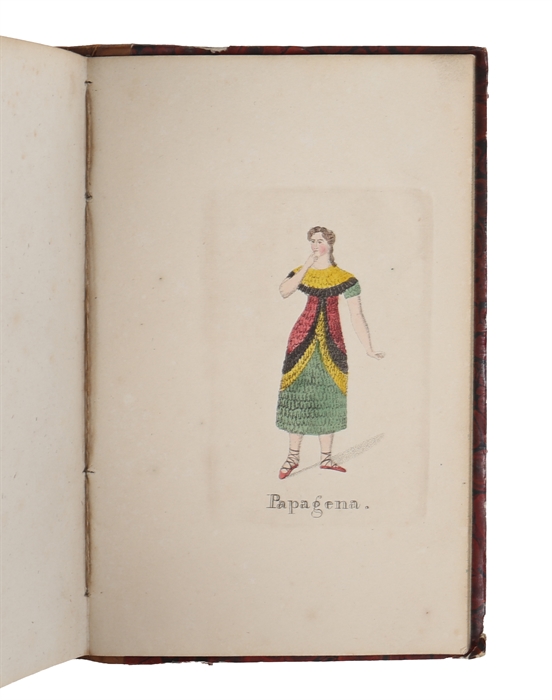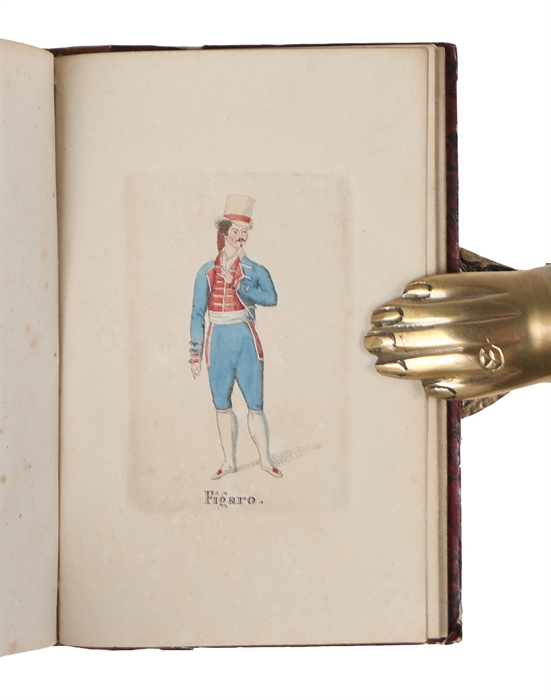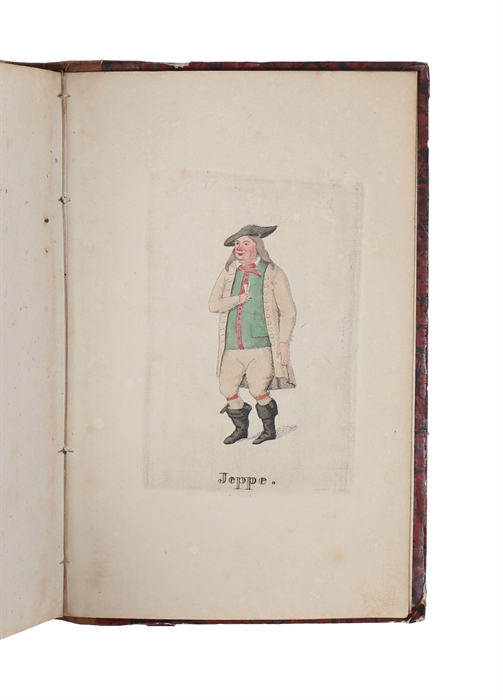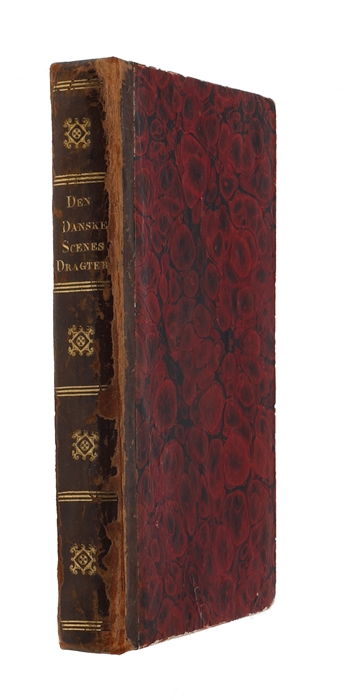ONE OF ONLY A HANDFUL OF COPIES KNOWN
[BRUUN, CHRISTIAN VOLMAR].
Samling af den danske Scenes Dragter i 48 colorerede Fremstillinger.
Kjöbenhavn (Copenhagen), Steens Forlag, 1834.
12mo (15 x 9,5 cm). Lovely contemporary brown half calf with gilt ornamentation to spine. General wear along hinges and edges of boards. But overall a very nice copy. Tight and fine. Book-plate of Kaj Christensen (1960'ies) to inside of front board and and ownership signatures to front free end-paper ("W. Unsgaard" and "N. Neiidendam / 1900") along with blindstamped ovnership stanp of Johan G. Melbye. Later pencil-annotation to inside of front board (stating that only tow copies are said to be preserved on private hands). VI, (2) pp. + 48 engraved and finely handcoloured plates. All the blank leaves inbetween the plates preserved as well.
Exceedingly scarce - one of only a handful of copies knwon to exist - first, and only, edition of Bruun’s “Collection of Costumes From the Danish Scene” from 1834, which contains 48 wonderful, engraved and handcoloured plates of costumes from some of the most famous plays and operas performed at the height of the Danish stage, including nine costumes to four of Mozart’s operas: La Nozze di Figaro, Don Giovanni, The Magic Flute, and Seraglio. These 48 magnificent plates showcase the wonderful diversity of the Danish stage at the time, the strong Gothic influence, the great influences of both German and French romanticism, and the influence of the Orient upon costumes of the Danish stage as well (eg. Seraglio, Lulu). In addition to the costumes for the operas by Mozart and for some of the most cherished Scandinavian plays (primarily Holberg), we have costumes for a wonderful array of other plays and operas that showcase the great influx upon Danish performance from many parts of Europe – Austria, Germany, France, Italy, United Kingdom. We have for instance Cinderella (Cendrillon), Monteverdi’s The Combat of Tancredi and Clorinda, La Dame Blanche, Beckford’s Azemia, Weber’s Der Freischutz and his Preciosa (which is based upon a novella by Cervantes). The full list of costumes is as follows: 1: Saft - i Sovedrikken. 2 & 3: Salomon Goldkalb & Brant – i Kong Salomon og Jörgen Hattemager. 4-6: Anna, Casper & Samiel - i Jaegerbruden. 7: Pantsatte Bondedreng – i Stykket af samme Navn (i.e. in the play by the same name). 8. Joseph – i Joseph og hans Brödre. 9 & 10: Montefiascone & Cendrillon - i Cendrillon. 11: Wenceslaus - i Herman von Unna. 12: Roux – i Röverborgen. 13: Hans Mortensen - i Aprilsnarrene. 14: Amenaide - i Taneredo. 15: Geert Westphaler - i Stykket af samme Navn (in the play by the same name). 16: Geske - i Den politiske Kandestöber. 17: Barthel - i Viinhösten. 18: Azemia - i Stykket af samme Navn (in the play by the same name). 19: Don Juan - i Stykket af samme Navn (in the play by the same name). 20 & 21: Jane & v. Thyboe - i Jacob v. Tyboe. 22 & 23: Preciosa & Pedro - i Preciosa. 24: Ariel - i Alfen som Page. 25 & 26: Valborg & Erland - i Axel og Valborg. 27 & 28: Hvide Dame & Georg Brovn – i Den hvide Dame. 29 & 30: Syvald & Rödhætten - i Deodata. 31-33: Almaviva, Bazile & Figaro - i Figaros Giftermaal. 34. Trampel - i Fugleskydningen. 35 & 36: Constance & Blonde - i Bortförelsen af Serailet. 37-39: Dilfeng, Barka & Lulu - i Lulu. 40 & 41: Mad. Voltisubito & Ledermann - i Recensenten og Dyret. 42: Zoe - i Væringerne i Miklagard. 43-45: Papageno, Monostatos & Papagena - i Trylleflöjten. 46 – 47: Mad. la Fleche & Arv - i Jean de France. 48: Jeppe - i Jeppe paa Bjerget. Many of the costumes with depiction of the actors and actresses are important in themselves and not only in a broader perspective - setting the tone for how to depict the characters in some of the most famous plays and operas for decades to come. An example of an individually highly significant illustration in the present work is the drawing of Christine Zrza in Constanze’s costume in Seraglio, wearing a so-called “Turkish” costume as a woman of the harem of Selim Pasha’s palace. Zrza herself was a significant figure in the foundation of Mozart’s operas on the Danish scene, playing also the first Countess Almavira in Figaro’s Marriage, the first Sextus in Titus, and the first Queen of the Night in The Magic Flute. The work is of immense scarcity, with only very few copies known to exist. Apart from the copy in the Royal Library in Copenhagen, OCLC list merely one copy, at Harvard. This copy only collates as having merely 1f. in addition to the 48 plates, where as our copy has all the four leaves in front consisting in title-page, contents-leaves and half-title. We have been able to locate one copy sold at auction, that having merely 43 plates. It is said that merely two copies are knbown on private hands. The great book collector Oscar Davidsen had a copy in his collection (nr. 5 in his auction catalogue (1940), where it is said of it that "this collection is of great scarcity). Krohn:1482.
Order-nr.: 62665

